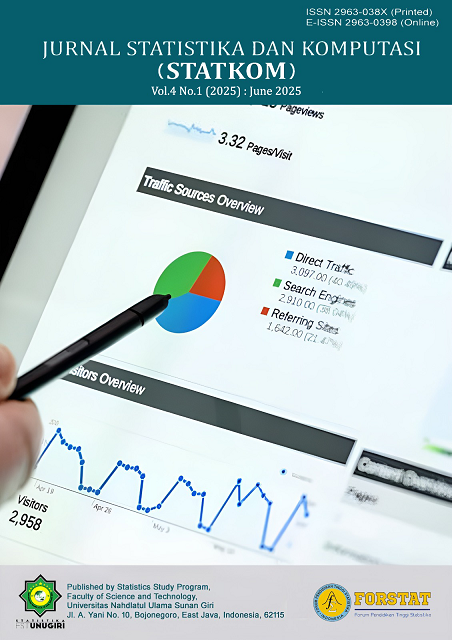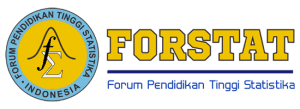Pemodelan Indeks Kualitas Lingkungan Hidup di Indonesia dengan Spline Truncated dan MARS
 PDF Download: 245
SIMILARITY INDEX Download: 0
PDF Download: 245
SIMILARITY INDEX Download: 0
DOI:
https://doi.org/10.32665/statkom.v4i1.4394Keywords:
IKLH, Spline Truncated, MARS, Nonparametric RegressionAbstract
Background: Indonesia, endowed with abundant natural resources, faces substantial challenges in maintaining environmental quality amid rapid urbanization and economic growth. The 2022 Environmental Performance Index ranked Indonesia 164th out of 180 countries with a score of 28.2. Regionally, Indonesia ranked 22nd among 25 Asia-Pacific countries. The Environmental Quality Index (EQI), crucial for achieving the Sustainable Development Goals (SDGs), was recorded at 72.42 in 2022, classified as "fair." This condition underscores the need for in-depth analysis of key factors influencing environmental quality.
Objective: This study aims to examine significant factors affecting the Environmental Quality Index (EQI) across Indonesian provinces using appropriate nonparametric statistical methods.
Methods: A nonparametric regression approach, specifically the Multivariate Adaptive Regression Spline (MARS) and the truncated spline multipredictor model, was applied. Predictor variables included the Human Development Index (HDI), population density, access to proper sanitation, poverty rate, and Gross Regional Domestic Product (GRDP). Secondary data for 34 provinces in 2022 were sourced from the Central Bureau of Statistics and the Ministry of Environment.
Results: The truncated spline model demonstrated superior performance, achieving a minimal MSE of 5.63308, minimal GCV of 10.42, and R2 of 82.63%, outperforming MARS, which yielded a minimal MSE of 7.685, GCV of 16.014, and R2 of 79.3%. All predictor variables significantly influenced EQI.
Conclusion: Social and economic factors were found to significantly affect environmental quality. The truncated spline approach offers an effective modeling alternative, providing critical insights to support environmental policy development at the provincial level.
References
B. W. Silverman. (1985). Some Aspects of the Spline Smoothing Approach to Non-Parametric Regression Curve Fitting. Journal of the Royal Statistical Society. Series B (Methodological), 47(1), 1–52. https://doi.org/10.1111/j.2517-6161.1985.tb01327.x
Badan Perencanaan Pembangunan Nasional (Bappenas). (2017). Pilar Pembangunan Lingkungan. Badan Perencanaan Pembangunan Nasional. https://sustainability.undip.ac.id/wp-content/uploads/2020/09/Pilar-Pembangunan-Lingkungan.pdf
Chamidah, N., Lestari, B., Budiantara, I. N., Saifudin, T., Rulaningtyas, R., Aryati, A., Wardani, P., & Aydin, D. (2022). Consistency and Asymptotic Normality of Estimator for Parameters in Multiresponse Multipredictor Semiparametric Regression Model. Symmetry, 14(2), 336. https://doi.org/10.3390/sym14020336
Dani, A. T. R., & Ni’matuzzahroh, L. (2021). Pemodelan Persentase Penduduk Miskin Kabupaten/Kota di Provinsi Jawa Barat dengan Pendekatan Regresi Nonparametrik Spline Truncated. J Statistika: Jurnal Ilmiah Teori Dan Aplikasi Statistika, 14(1), 24–29. https://doi.org/10.36456/jstat.vol14.no1.a3840
Friedman, J. H. (1991). Multivariate Adaptive Regression Splines. The Annals of Statistics, 19(1). https://doi.org/10.1214/aos/1176347963
Hardle, W. (1994). Applied Nonparametric Regression. Cambridge University Press.
Islamiyati, A., Anisa, A., Raupong, R., Massalesse, J., Sirajang, N., Sahriman, S., & Wahyuni, A. (2022). Estimasi Model Regresi Spline Kubik Tersegmen dengan Metode Penalized Least Square. Al-Khwarizmi : Jurnal Pendidikan Matematika Dan Ilmu Pengetahuan Alam, 10(2), 139–148. https://doi.org/10.24256/jpmipa.v10i2.3197
Kementerian Lingkungan Hidup Dan Kehutanan. (2023). Profil Indeks Kualitas Lingkungan Hidup 2022. https://ppkl.menlhk.go.id/website/index.php?q=1158&s=9bd7909ea32c89f68e82ed0cbe1f30a2e1d72b1c
Kementerian Lingkungan Hidup dan Kehutanan Republik Indonesia. (2022). Kualitas Lingkungan Hidup Indonesia Meningkat dalam Lima Tahun Terakhir. Https://Ppid.Menlhk.Go.Id/Berita/Siaran-Pers/6972/Kualitas-Lingkungan-Hidup-Indonesia-Meningkat-Dalam-Lima-Tahun-Terakhir
Khoirunnisa, W., Fatekurohman, M., & Tirta, I. M. (2024). Analisis Ketahanan Hidup Pasien COVID-19 Menggunakan Pendekatan Multivariate Adaptive Regression Spline (MARS). Jurnal Statistika Dan Komputasi, 3(1), 11–21. https://doi.org/10.32665/statkom.v3i1.2700
Lestari, B., Fatmawati, Budiantara, I. N., & Chamidah, N. (2018). Estimation of Regression Function in Multi-Response Nonparametric Regression Model Using Smoothing Spline and Kernel Estimators. Journal of Physics: Conference Series, 1097, 012091. https://doi.org/10.1088/1742-6596/1097/1/012091
Qudratullah, M. F. (2013). Analisis Regresi Terapan Teori, Contoh Kasus dan Aplikasi dengan SPSS. Andi Offset.
Risambessy, S., Aulele, S. N., & Lembang, F. K. (2022). Misclassification Analysis of Elementary School Accreditation Data in Ambon City Using Multivariate Adaptive Regression Spline. Jurnal Matematika, Statistika Dan Komputasi, 18(3), 394–406. https://doi.org/10.20956/j.v18i3.19451
Steinberg, D. (1999). MARS User Guide. Salford System.
Wibowo, A. (2019). Multivariate Adaptive Regression Splines Modeling For Household Food Security In Central Borneo Province 2017. Global Science Education Journal, 1(1), 39–47. https://jurnal.sainsglobal.com/index.php/ges/article/view/517
Yale College. (2022). Yale Center for Environmental Law & Policy. 2022 EPI Results - Environmental Performance Index. Yale Center for Environmental Law & Policy. https://epi.yale.edu/epi-results/2022/component/epi
Downloads
Published
Issue
Section
License
Copyright (c) 2025 Marfa Audilla Fitri, Suliyanto Suliyanto, M Fariz Fadillah Mardianto, Elly Ana

This work is licensed under a Creative Commons Attribution-ShareAlike 4.0 International License.
Authors who publish with this journal agree to the following terms:
- Authors retain copyright and grant the journal right of first publication with the work simultaneously licensed under a Creative Commons Attribution License - Share Alike that allows others to share the work with an acknowledgment of the work's authorship and initial publication in this journal.
- Authors are able to enter into separate, additional contractual arrangements for the non-exclusive distribution of the journal's published version of the work (e.g., post it to an institutional repository or publish it in a book), with an acknowledgment of its initial publication in this journal.
- Authors are permitted and encouraged to post their work online (e.g., in institutional repositories or on their website) prior to and during the submission process, as it can lead to productive exchanges, as well as earlier and greater citation of published work.
USER RIGHTS
All articles published Open Access will be immediately and permanently free for everyone to read and download. We are continuously working with our author communities to select the best choice of license options, currently being defined for this journal as follows:
 PDF Download: 245
SIMILARITY INDEX Download: 0
PDF Download: 245
SIMILARITY INDEX Download: 0












